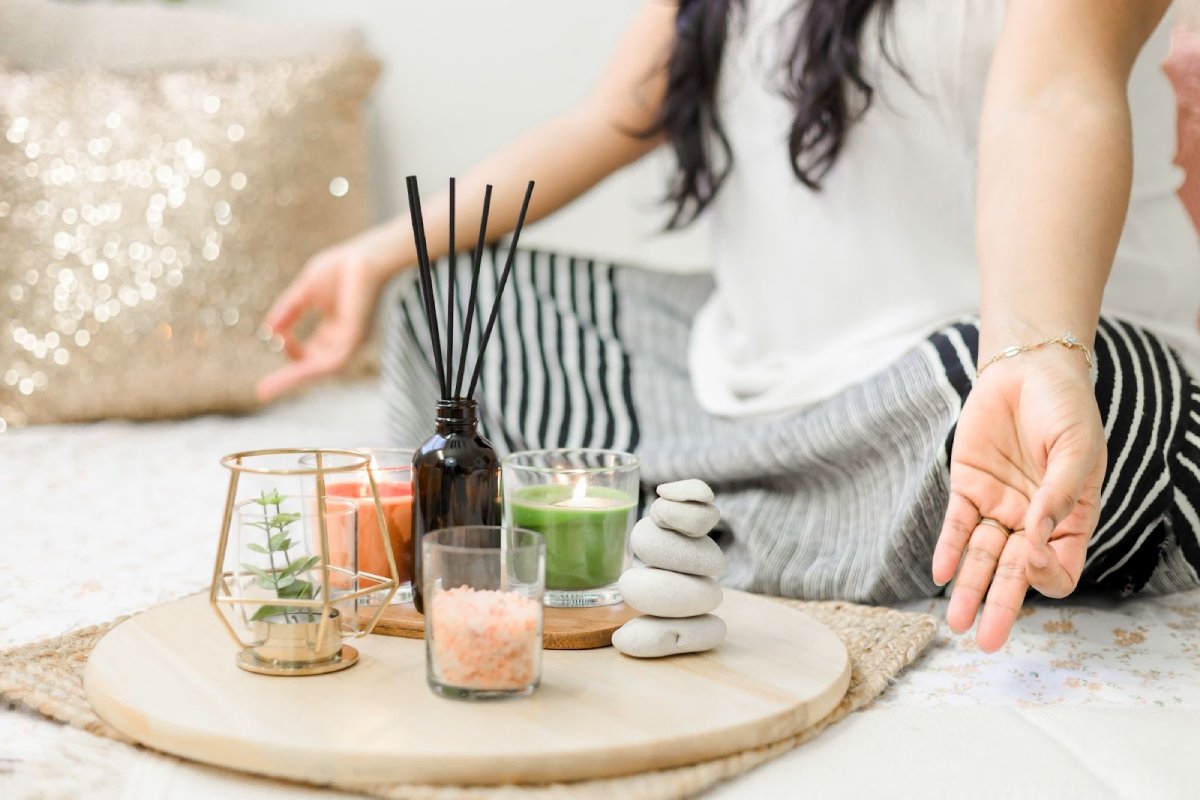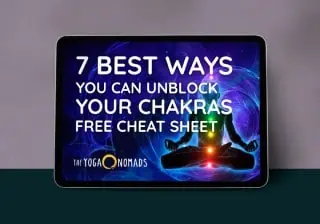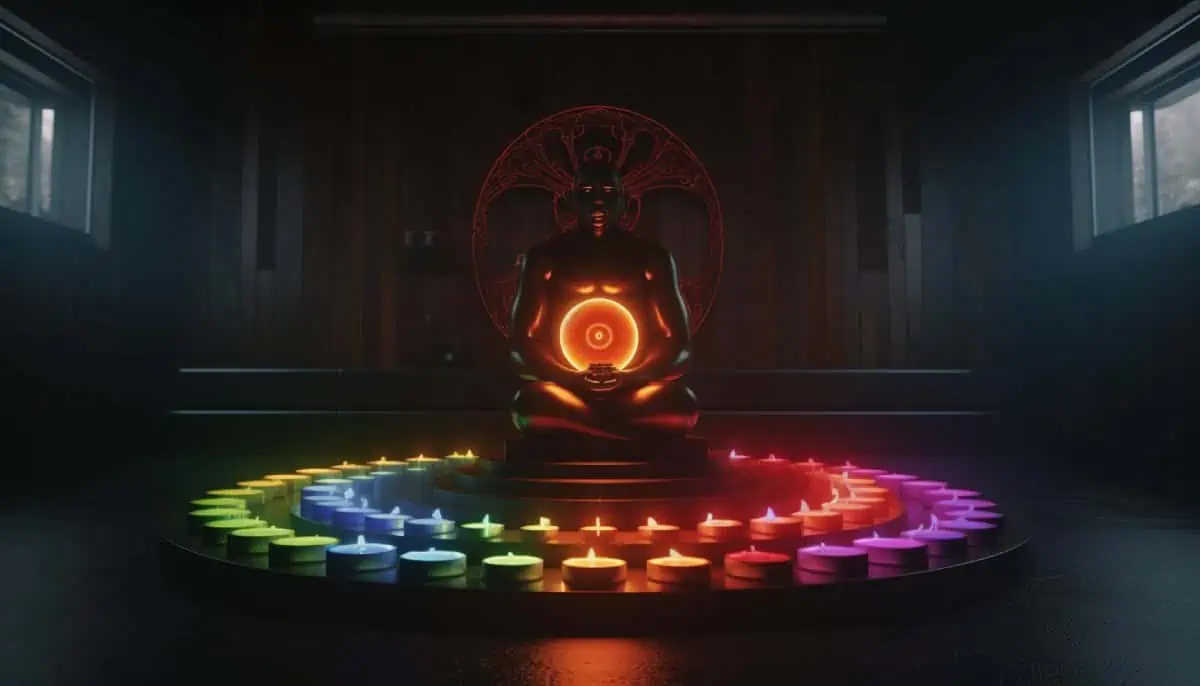Over recent years, meditation has become a widespread stress-busting tool, helping people find calm amidst their busy lives. However, many people don’t realize meditation dates back to as early as 5,000 BCE and has strong roots in Hinduism, Buddhism, and other religions.
Because of its rich history, you can find many different types of meditation, from stillness practices to dynamic styles. However, as more and more people become intrigued by the chakra system and the energetic body, chakra meditation is gaining much attention.
So what exactly is chakra meditation, how do you do it, and how does it affect how we feel physically, energetically, and emotionally? Let’s find out.
Contents
What are the 7 chakras?

Before we dive into chakra meditation, let’s go over the chakra system and its seven major energy centers. The seven chakras are said to run along the spine from the tailbone to the top of the head. They are not part of the physical body, so you cannot see them, even on an x-ray or CT scan.
Instead, the chakras belong to what is known as the subtle body. The ancient Hindu text Bhagavad Gita describes this as a combination of the mind, intellect, and ego, containing various energetic layers that make up a human being.
Free Cheat Sheet: The 7 Best Ways to Unblock Chakras
Download nowThe chakras are worth knowing about as they govern certain aspects of our being. For example, they control our self-image, our ability to regulate emotions, self-expression, intuition, spiritual connection, and more. If one of these energy centers is blocked, we may experience the negative effects either physically, mentally, emotionally, or all three.
For years, ancient yogis have sought to align and open all seven major chakras in the hope that they experience peace and bliss and, eventually, spiritual awakening.
What is a chakra meditation?
Thanks to the vast amount of chakra knowledge we have today, anyone can balance and heal their chakras. However, it’s important to note that the chakra system is not yet scientifically proven. Hence, there is no way to know if any chakra balancing methods actually work.
One of the simplest and most popular techniques for working with the chakras is meditation. Each energy center has an associated body part, color, element, mudra, and mantra, all of which can be used in meditation to direct positive energy to that chakra. Chakra meditation can also feature music tuned to a specific frequency to break up blockages and help the life force flow freely.
If you are new to chakra meditations, it’s best to use guided versions, which you can find on Youtube and meditation apps. Guided chakra meditations may focus on one chakra only or include healing for all seven. In the following sections, we’ll share how to balance each chakra individually through meditation and how to perform a complete “chakra tune-up.”
Root chakra meditation
- Position: Tailbone
- Color: Red
- Element: Earth
- Frequency: 396 Hz
- Mantra: Lam
The root chakra, known as the Muladhara chakra in Sanskrit, is the first of the seven chakras located at the tailbone. The first chakra governs security, stability, and our basic needs. This energy center helps us feel grounded, centered, and connected to our bodies and physical world.
To meditate on the root chakra, you can:
- Visualize a red energy ball at the base of the spine, drawing energy downwards to the earth.
- Focus on the earth element and feel your connection to the ground through your sitting bones and feet.
- Visualize a solid and steady tree withstanding a strong storm.
- Chant the mantra lam, like in this chanting meditation.
- Incorporate affirmations like “I am safe” or “I am stable.”
- Meditate to music tuned to the root chakra frequency of 396 Hz.
- Use the Muladhara mudra, as shown below.

Here is a powerful root chakra meditation that features affirmations and energy visualization.
Sacral chakra meditation
- Position: Reproductive organs
- Color: Orange
- Element: Water
- Frequency: 417 Hz
- Mantra: Vam
The sacral chakra, also known as the Svadhisthana chakra, sits close to the reproductive organs in the lower abdomen. It is responsible for our creativity, physical desires, ability to connect to the senses, and emotional regulation. It is also associated with passion, pleasure, and feeling purpose in life.
To meditate on the sacral chakra:
Chakra Test: Discover Your Strongest, and Weakest, Chakras
Take the free test- Visualize orange energy in the lower belly and watch it slowly expand out to your hips.
- Visualize water in the form of oceans, lakes, and rivers while letting emotions arise and pass.
- Chant the vam mantra.
- Incorporate affirmations like “I unleash my creative potential” or “I am in control of my emotions.
- Meditate to sacral chakra frequency music.
- Use the Shakti mudra, which contains feminine energy, to harness passion and desire.
This guided sacral chakra mediation includes visualization and affirmations, working with the energy center’s qualities.

Solar plexus chakra meditation
- Position: Upper abdomen
- Color: Yellow
- Element: Fire
- Frequency: 528 Hz
- Mantra: Ram
The solar plexus chakra, also called the Manipura chakra, is located in the upper abdomen. It governs our self-esteem, self-confidence, courage, inner strength, and resilience. This fiery center works with the sacral chakra to connect to our passion and purpose and then take action. It also helps build discipline and persistence.
To use meditation to balance the third chakra, you can:
- Visualize a yellow energy ball or in the sun in the core center.
- Connect to the fire element by imagining a ball of fire in your belly.
- Visualize yourself doing something that scares you, or remember when you stepped outside your comfort zone and how good you felt.
- Chant the mantra yam.
- Incorporate affirmations like “I am courageous” or “I can achieve anything I set my mind to.”
- Meditate to solar plexus chakra frequency music.
- Hold the Rudra mudra, also known as the gesture of strength.
This short Manipura chakra meditation brings you into a relaxed state before leading you into a visualization of the solar chakra qualities.

Heart chakra meditation
- Position: Center of chest
- Color: Green
- Element: Air
- Frequency: 639 Hz
- Mantra: Yam
The heart chakra or Anahata chakra sits in the center of the chest. It promotes the qualities of unconditional love, compassion, gratitude, and joy. The fourth chakra helps us foster deeper connections with others, give and receive love, release judgments, and forgive.
To meditate on the heart chakra:
- Envision green healing energy in the center of your heart. Allow the green energy to wash over you as you focus on the qualities of love, compassion, and empathy.
- Practice gratitude, bringing to mind three things you are grateful for.
- Chant the mantra yam.
- Speak positive affirmations like “I am worthy of love” or “I give and receive love fully.”
- Meditate to heart chakra frequency music.
- Learn the Hridaya Mudra to release any emotional tension.
This 20-minute heart chakra meditation features an excellent visualization to connect you deeply to the qualities of love and joy.
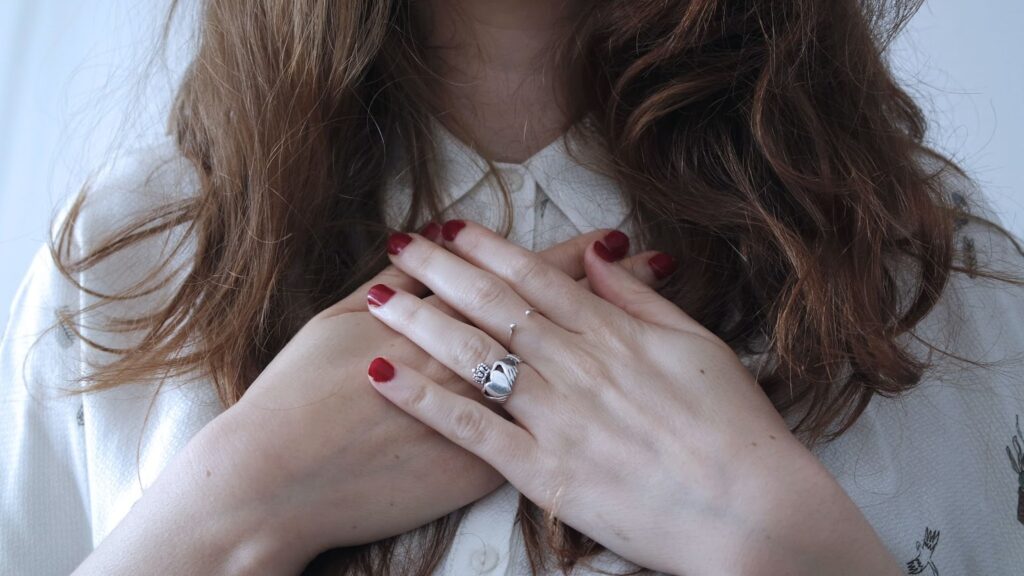
Throat chakra meditation
- Position: Center of throat
- Color: Blue
- Element: Space
- Frequency: 741 Hz
- Mantra: Ham
The throat chakra (Vishuddha) is responsible for our ability to communicate our ideas, emotions, and beliefs. In addition, the fifth chakra helps us listen to others and speak our truth.
To balance the throat chakra through meditation:
- Visualize a blue energy ball spinning in your throat and then expanding outwards, breaking through any communication blockages.
- Imagine yourself speaking confidently in front of a large crowd while inviting in the feeling of self-confidence.
- Chant the mantra Ham.
- Speak aloud affirmations like “I speak my truth.”
- Listen to music tuned to the throat chakra frequency.
- Hold the Granthita Mudra to nourish your throat and thyroid.

This guided throat chakra meditation blends visualization techniques with affirmations.
Third eye chakra meditation
- Position: Between the eyebrows
- Color: Indigo
- Frequency: 852 Hz
- Mantra: Aum
The third eye chakra (Ajna) is our vision, intuition, and imagination center. This energy center allows us to connect with our inner wisdom and guidance. Moreover, because the reflective sixth chakra clears the mind, it heightens strategic thinking, aids the creative process, and increases spiritual awareness.
To open the third eye chakra, try these meditation techniques:
- Focus on the space between the eyes while visualizing indigo-colored energy. Watch this blue vitality expand and fill the brain.
- Get in touch with the power of visualization with a manifestation practice.
- Chant the mantra Aum.
- Listen to meditation music with a frequency of 852 Hz.
- Use the Mahasirs mudra (The Mudra of the Great Head) to help clear your mind and relieve mental tension.
This short guided third eye meditation will help you connect to your intuition in just 10 minutes using powerful visualization techniques.
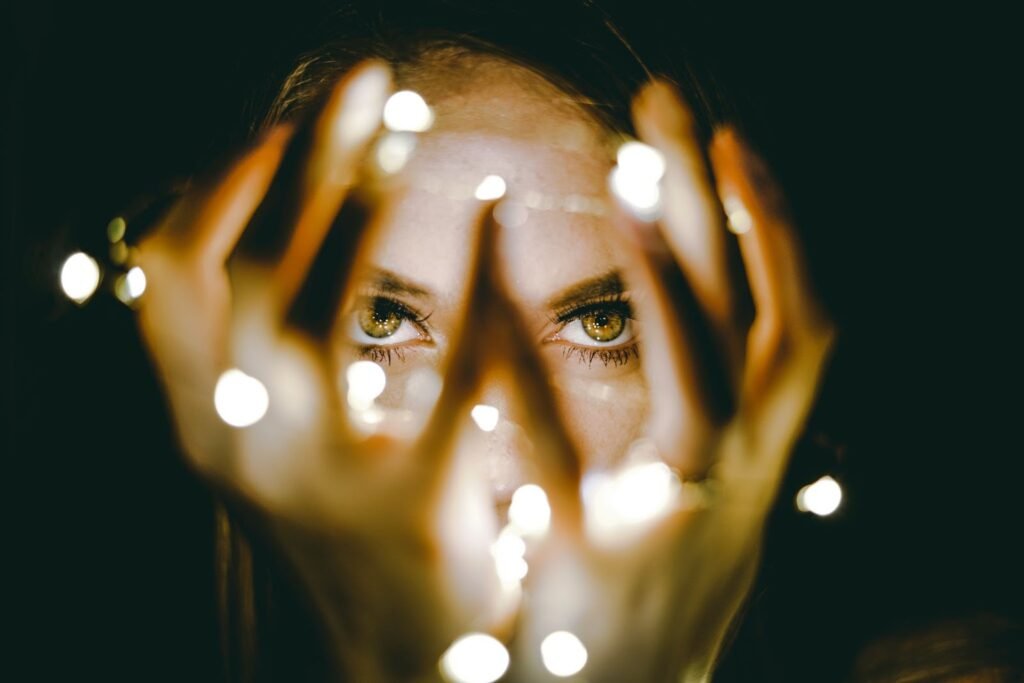
Crown chakra meditation
- Position: Top of the head
- Color: Purple
- Frequency: 963 Hz
The crown chakra (Sahasrara) represents spiritual connection and enlightenment. It is also linked with self-mastery and allows one to feel a connection with all living things, rather than seeing themself as a separate entity.
You can use these mediation techniques to help open the crown chakra and experience a greater connection to the divine:
- Visualize a spinning crown of bright, white light above your head. Imagine the light coming down from the universe, entering the crown of your head, and filling your body with healing, spiritual energy.
- Meditate while listening to music with a 963 Hz frequency.
- Hold your arms above your head in The Mudra of a Thousand Petals. Simply connect the thumbs and index fingers, pointing the other fingers up and out.
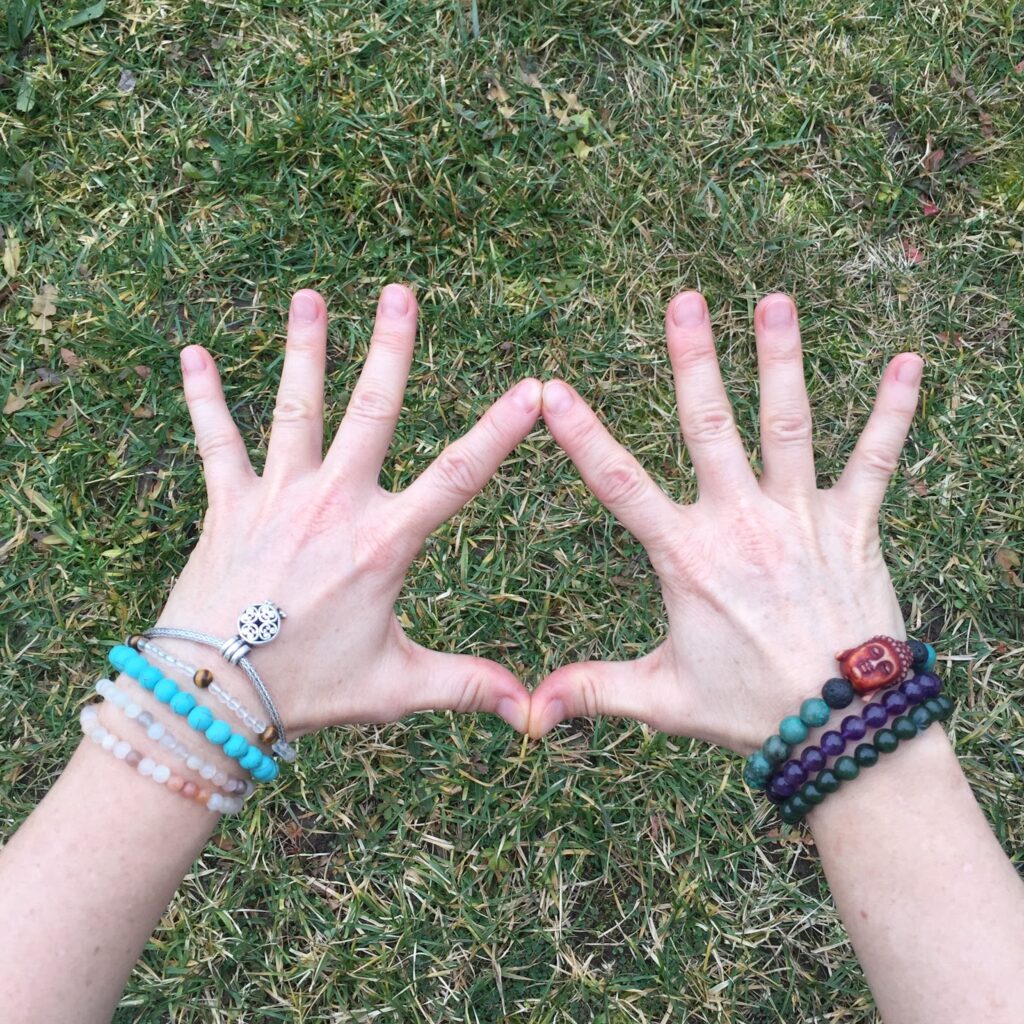
This 10-minute crown chakra meditation combines visualization of the white light crown chakra energy and affirmations to help you reach higher states of consciousness.
Full chakra tune-up meditation
Choosing to meditate on a specific chakra can be highly beneficial if you feel one energy center is out of balance or if you want to target a specific function. However, a complete chakra tune-up will allow you to connect to and align all chakras.
In a chakra balancing tune-up, you will spend time at each chakra, beginning at the root and ending at the crown. While you focus on each energy center, you can visualize the chakra’s color and chant the associated mantra. For example, this guided chakra balancing meditation prompts you to imagine the chakra colors and feel the qualities of each one.
Once you finish at the Sahasrara chakra, slowly draw the energy back down the spine and chakra system, pausing for a breath or two at each point until you reach the Muladhara.
Final Thoughts
Meditation can be a powerful way to heal blocked chakras and bring alignment to your subtle body. Before starting any of the above meditations, relax your body and calm your mind first. Find a position where you can sit comfortably, close your eyes and breathe deeply for five minutes before you begin.


